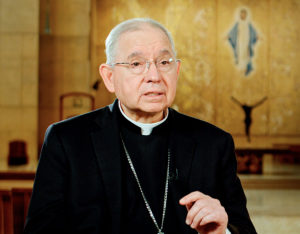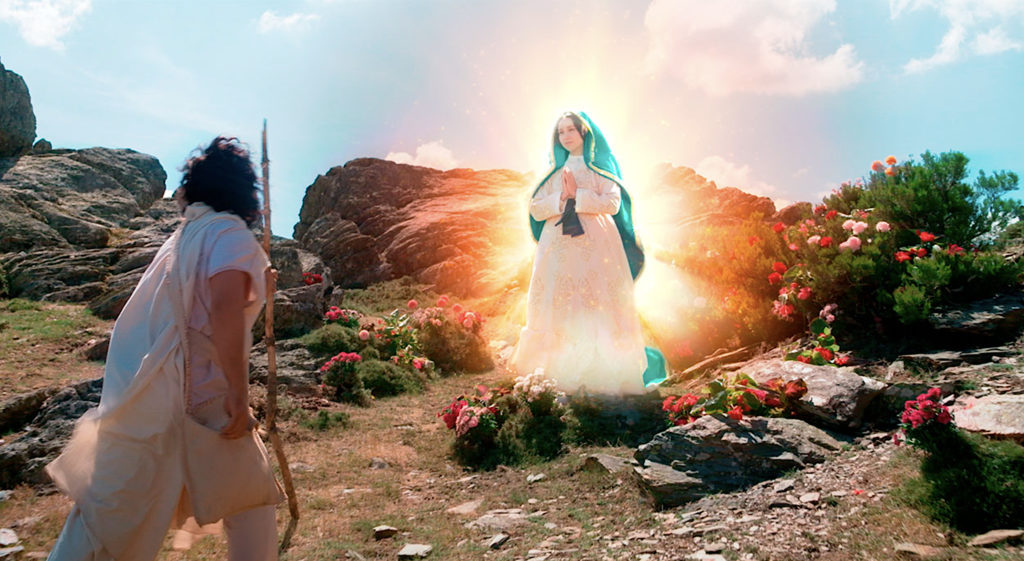For many American Catholics, the immense footprint left by Our Lady of Guadalupe in the hearts and lives of millions of their co-religionists in the Southern Hemisphere remains something of a secret. This is a great shame, for she has been the Empress of the Americas since 1945 by papal decree, and, one could say, by heavenly mandate since her apparition in 1531.
A new movie, “Guadalupe: Mother of Humanity,” which opened Feb. 22 in the U.S., proposes to break open the whole glorious story to a people that are no less in need of evangelization than the indigenous inhabitants of 16th-century America.
Spanish filmmaker Pablo Moreno weaves together the narrative of Our Lady’s apparitions on the hill Tepeyac to Juan Diego, a humble convert, with heartfelt testimonies of modern individuals who have also felt her presence in their lives, including LA’s own Archbishop José H. Gomez.
The result is a compelling, moving, piece of art with the potential to win over new hearts to Our Lady and her son.
The film treats viewers to aerial views of the thousands who throng up the long and wide avenue to her shrine in Mexico City on her feast day, carrying bouquets and babies, or dragging themselves along on their knees as a sign of penitence.
The mariachis sing her special song, “Las Mañanitas,” which is also the typical song Mexicans sing to their loved ones on the days of their santos, (“patron saints”). At her shrine we see the pilgrims who have traveled from all over the world to see and venerate the miraculous image, and we watch their awe as they take in their first sight of La Morenita’s face.
In one sense, the 500-plus year story is the story of an image, a painting on cloth which has mesmerized millions over the centuries. It has been reproduced more often than any other image, according to the narrator, and it has been diffused over the whole world.
The image has been closely studied, and we learn about one particularly moving finding: Drawn infinitesimally small in her pupils are two sets of people. In one are those who were watching when Juan Diego revealed the image on his tilma (“cloak”). In the other is an image of a family, the mother at its center, with baby and child, father and grandparents.
The message in her eyes? My family, your family, is in the special care of Our Lady of Guadalupe.

Moreno reverts to the pretty scene of 1531— the shimmering Lady on the dry and rocky mount again and again, seeking to explain the enormity of the transformation she provoked. The situation in New Spain was dire, as far as transmission of the faith was concerned.
The conquistadors (“conquerors”) found a culture bathed in the blood of innocents, worshiping pagan gods that demanded sacrifice and whose thirst was never quenched. Up to 20,000 babies, children, and adults a day, tortured and torn on the great pyramids, to ensure the rising of the sun and the regularity of the rains.
When the Franciscan friars introduce the bizarre idea that God’s mercy falls unmerited on the earth and its inhabitants, out of a concept called “divine love,” it seemed incomprehensible to these people.
But the film’s scenes of Juan Diego’s encounters with Our Lady reveal the clues to her success. (After her apparition many millions converted, and we are told of priests hounded and harried by throngs of men and women begging for baptism.) It is her serene confidence and her warm tenderness, that of the perfect mother, whose very gaze is enough to soothe the most troubled heart. Her words to Juan Diego have been immortalized:
“Hear me and understand well, my little son, that nothing should frighten or grieve you. Let not your heart be disturbed. Do not fear any sickness or anguish. Am I not here, who is your Mother? Are you not under my protection? Am I not your health? Are you not happily within the fold of my mantle, within the cross of my arms?”
The Virgin (played by Angelica Chong) speaks to Juan Diego with infinite sweetness and calm strength, laying a difficult task on him:
“Tell the bishop to build me a little house on this plain … so that I may therein exhibit and give all my love, compassion, help, and protection, because I am your merciful mother.”
In that temple, she says, she will “listen there to their lamentations, and remedy all their miseries, afflictions, and sorrows.”
The movie-watcher who learns for the first time of the radical transformation of the Americas achieved by Our Lady of Guadalupe’s apparition on Tepeyac begins to understand. A people whose conception of the divine was inseparable from cruelty and terror were introduced instead to a God of compassion, mediated by the tenderness of the ideal mother, a tenderness they can understand as all humans can.
She offers them a transcendent vision in which each one of them, from the lowly Juan Diego to the most afflicted, is caught up in soft but powerful arms — arms that cradle but also ward off the terrible sadism of the pagan gods that took so much from them. In the image she stands on the moon and blocks the sun, symbols of the discarded tyrants.
There is a timeliness to this movie. Our modern culture is not so different from the one that Our Lady of Guadalupe transformed over 500 years ago. We also suffer under strange and bloodthirsty gods — of radical individualism and hedonism. We toil to placate the god of wealth and honor, and our families implode. The most common altar of our sacrifice? Abortion, where our unborn children die by the many hundreds of thousands because we believe it makes us free.
Our Lady may visit us again, and transform us anew. But until she does, this film may be a sign to many that the only God is the God of love, and his mother is the sure road to His Heart.

